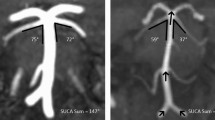Abstract
Initially described more than 40 years ago, basilar-type migraine has posed diagnostic and therapeutic dilemmas for medical practitioners. Defined by the coexistence of migraine headache with neurological symptoms emanating from either the brainstem or simultaneously from both cerebral hemispheres, basilar-type migraine has been categorized as “atypical” or “complicated” and has been considered more akin to hemiplegic migraine than to migraine with typical aura. Despite the absence of any data convicting basilar-type migraine as a vasospastic condition, the use of triptans in such patients has been considered prohibited. This review focuses on the diagnosis, clinical presentation, available genetic information, and treatment considerations in patients with basilar-type migraine.
Similar content being viewed by others
References and Recommended Reading
Bickerstaff ER: Basilar artery migraine. Lancet 1961, 1:15–17.
Headache Classification Committee of the International Headache Society: The International Classification of Headache Disorders, 2nd ed. Cephalalgia 2004, 24(Suppl 1):9–160.
Lapkin ML, Golden GS: Basilar-artery migraine: a review of 30 cases. Am J Dis Child 1978, 132:278–281.
Voetsch B, DeWitt D, Pessin M, Caplan L: Basilar artery occlusive disease in the New England Medical Center Posterior Circulation Registry. Arch Neurol 2004, 61:496–504.
Kaniecki RG: The lack of specificity of International Headache Society criteria in distinguishing basilar migraine from migraine with typical aura. Headache 2003, 43:510.
Kirchmann M, Thomsen L, Olesen J: Basilar-type migraine: clinical, epidemiologic, and genetic features. Neurology 2006, 66:880–886.
Kirchmann M: Migraine with aura: new understanding from clinical epidemiologic studies. Curr Opin Neurol 2006, 19:286–293.
Russell MB, Olesen J: Increased familial risk and evidence of genetic factor in migraine. BMJ 1995, 311:541–544.
Ulrich V, Gervil M, Kyvik K, et al.: Evidence of a genetic factor in migraine with aura: a population-based Danish twin study. Ann Neurol 1999, 45:242–246.
Ophoff RA, Terwindt GM, Vergouwe M: Familial hemiplegic migraine and episodic ataxia type-2 are caused by mutations in the Ca2+ channel gene CACNL1A4. Cell 1996, 87:543–552.
DeFusco M, Marconi R, Silvestri L: Haploinsufficiency of ATP1A2 encoding the Na+/K+ puma alpha2 subunit associated with familial hemiplegic migraine type 2. Nat Genet 2003, 33:192–196.
Dichgans M, Freilinger T, Eckstein G: Mutation in the neuronal voltage-gated sodium channel SCN1A in familial hemiplegic migraine. Lancet 2005, 366:371–377.
Ambrosisni A, D’Onofrio M, Grieco G, et al.: Familial basilar migraine associated with a new mutation in the ATP1A2 gene. Neurology 2005, 65:1826–1828.
Haan J, Terwindt G, Ophoff R, et al.: Is familial hemiplegic migraine a hereditary form of basilar migraine? Cephalalgia 1995, 15:477–481.
Thomsen L, Eriksen M, Roemer S, et al.: A population-based study of familial hemiplegic migraine suggests revised diagnostic criteria. Brain 2002, 125:1379–1391.
Thomsen L, Ostergaard E, Olesen J, Russell M: Evidence for a separate type of migraine with aura: sporadic hemiplegic migraine. Neurology 2003, 60:595–601.
Klapper J, Mathew N, Nett R: Triptans in the treatment of basilar migraine and migraine with prolonged aura. Headache 2001, 41:981–984.
Lewis D, Paradiso E: A double-blind dose comparison study of topiramate for prophylaxis of basilar-type migraine in children: a pilot study. Headache 2007, 47:1409–1417.
Artto V, Nissil M, Wessman M, et al.: Treatment of hemiplegic migraine with triptans. Eur J Neurol 2007, 14:1053–1056.
Hockaday J: Basilar migraine in childhood. Dev Med Child Neurol 1979, 21:455–463.
Kuhn W, Kuhn S, Daylida L: Basilar migraine. Eur J Emerg Med 1997, 4:33–38.
Sturzenegger M, Meienberg O: Basilar artery migraine: a follow-up study of 82 cases. Headache 1985, 25:408–415.
Author information
Authors and Affiliations
Corresponding author
Rights and permissions
About this article
Cite this article
Kaniecki, R.G. Basilar-type migraine. Current Science Inc 13, 217–220 (2009). https://doi.org/10.1007/s11916-009-0036-7
Published:
Issue Date:
DOI: https://doi.org/10.1007/s11916-009-0036-7




